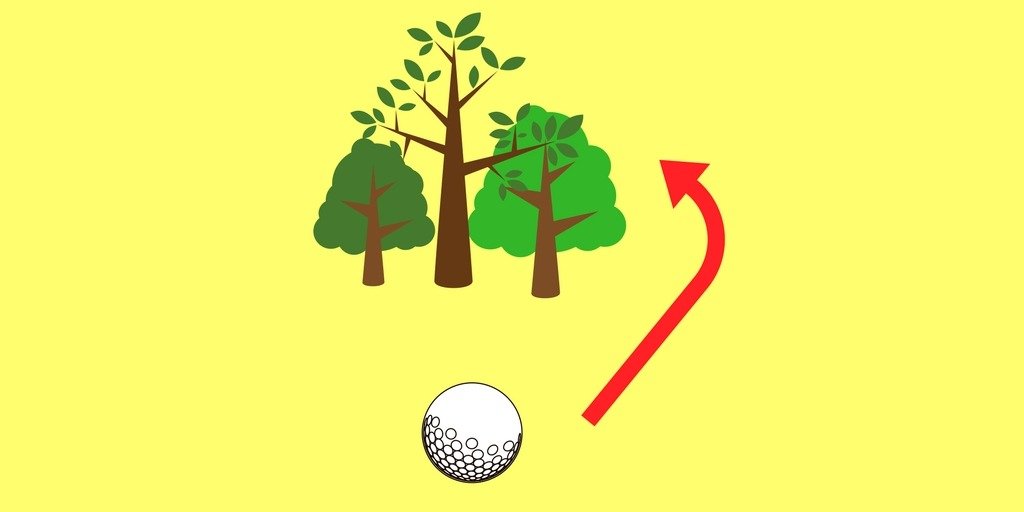
This is a guest post by Ryan Chaney
A critical shot that I believe every golfer should have in their pocket is the low hook. It can get you out of trouble and save you tons of strokes. Executing this shot with confidence is all about a functional address position and a lot of practice.
In this article we’re going to discuss the key steps to make sure you know how to hit a low hook.
Club selection
When choosing a club to hit the low hook from trouble, you want to make sure you choose a high enough loft to get the ball out of the rough, but low enough to make it easier to curve the golf ball.
I believe the sweet spot for most golfers is a 6-iron/hybrid.
Technique
First off, stay calm - you don’t have to make any swing changes to hit this shot well.
Execution of the low hook is mostly about the address position. The beginning of the ball’s flight will start very close to where the clubface is aimed at impact, so aim the face where you’d like to start the golf ball. Build your stance after you’ve aimed the clubface.
Make sure to give yourself a little margin for error when you’re trying to hook it around some trees. The last thing you want to worry about is a temporary Titleist tattoo in your forehead a second after impact.

Now that you have aimed the face where you would like the ball to start, build your stance with your body aimed significantly to the right of where you’ve aimed the face. Make your body alignment feel foolishly offline.
This is a shot best learned by exaggerating a bit at first, and perhaps over curving it.
As for ball position, let’s keep it simple and play the ball where you’d normally play it for your club of choice. If you need to change trajectory I suggest you change clubs. Messing around with different ball positions to change the ball’s trajectory only complicates things.
The Feel
You need clubhead speed to really get that ball curving, but it’s not uncommon for obstacles to be in the way. Trees, branches, roots and fences are all things that can make this swing feel a little claustrophobic.
The direction the club travels should feel normal to you. You took care of the ball flight at address. The feel of the swing is about creating power and insuring you catch the ball first in a potentially restricted space.
A familiar feeling would be one of a buried bunker shot. The emphasis there is about making sure you’ve created enough speed to get the ball out of that wet sand that swallowed your new Pro V1.
Your swing had a short follow-through because the earth absorbed the blow after impact. Your swing also had a shorter than stock backswing because you were in the sand, and we didn’t want to lose our footing and compromise our impact. But with that shorter backswing and muted follow through, boy did that swing have speed.
How to Practice the Low Hook
If you’re right handed, move yourself to the far end of the left side of the range (of course opposite for lefties). Go through your normal warm up.
Now place your hook practice balls in some shallow divots you created in your warm up. Aim your clubface down the middle of the range. Aim your body far right. Far enough right so that if the ball flew there, no range picker would ever find it.
Now make your aggressive buried bunker shot swing. Enjoy watching the ball start where you aimed that face and turn hard away from where you’ve aimed your body. Massage the address position as you see fit based on your results.
Remember to have fun and really explore the boundaries of how far offline you can aim your body until you find it difficult to make contact.
On Course Expectations
When executed well the ball will be flying low and moving fast. If you’re hitting this shot into a green, get a yardage to the front of the green because it’s not going to stop quickly. If you have room to run it up, use it.
Again, this ball will be coming in hot. You should have practiced this shot enough on the range to know it’s going to curve the desired direction on the course. I’ll remind you again to give yourself plenty of space between your start line and the tree. It’s better to have it curving the desired direction and advancing it a long way than biting off more than you can chew.
Final Thoughts
In my opinion these are the types of shots skilled golfers embrace. Practice it enough so that when you encounter a scenario that requires this shot on the course, you look forward to the challenge of hitting the low hook instead of sighing as you accept defeat as you pitch out with your sand wedge.
We care about the protection of your data Read our Privacy Policy